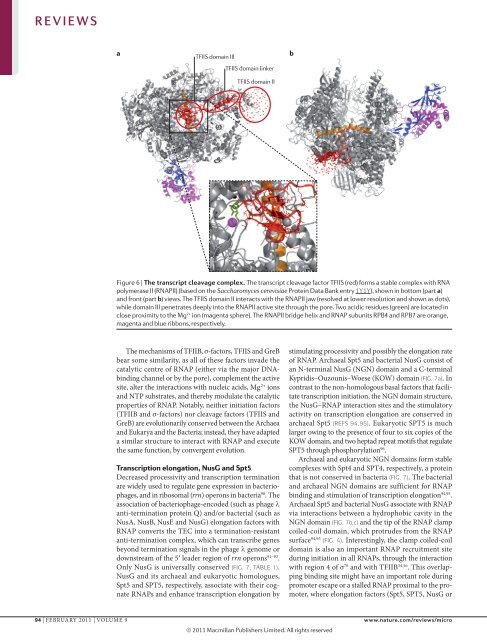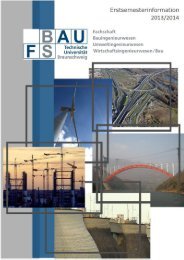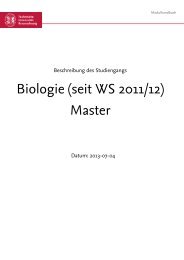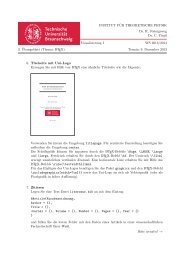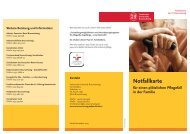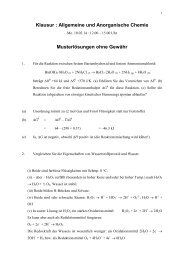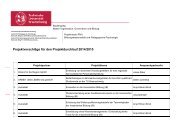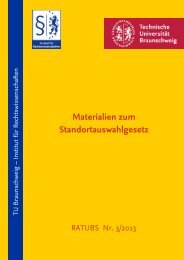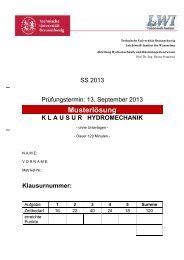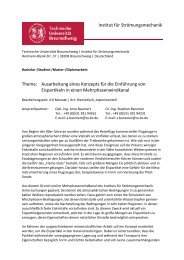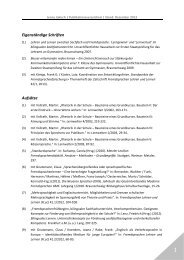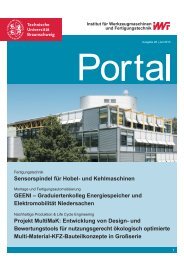L - Technische Universität Braunschweig
L - Technische Universität Braunschweig
L - Technische Universität Braunschweig
Create successful ePaper yourself
Turn your PDF publications into a flip-book with our unique Google optimized e-Paper software.
REVIEWS<br />
a<br />
TFIIS domain III<br />
TFIIS domain linker<br />
TFIIS domain II<br />
b<br />
Figure 6 | The transcript cleavage complex. The transcript cleavage factor TFIIS (red) forms a stable complex with RNA<br />
polymerase II (RNAPII) (based on the Saccharomyces cerevisiae Protein Data Bank entry 1Y1Y), Nature shown Reviews in bottom | Microbiology<br />
(part a)<br />
and front (part b) views. The TFIIS domain II interacts with the RNAPII jaw (resolved at lower resolution and shown as dots),<br />
while domain III penetrates deeply into the RNAPII active site through the pore. Two acidic residues (green) are located in<br />
close proximity to the Mg 2+ ion (magenta sphere). The RNAPII bridge helix and RNAP subunits RPB4 and RPB7 are orange,<br />
magenta and blue ribbons, respectively.<br />
The mechanisms of TFIIB, σ-factors, TFIIS and GreB<br />
bear some similarity, as all of these factors invade the<br />
catalytic centre of RNAP (either via the major DNAbinding<br />
channel or by the pore), complement the active<br />
site, alter the interactions with nucleic acids, Mg 2+ ions<br />
and NTP substrates, and thereby modulate the catalytic<br />
properties of RNAP. Notably, neither initiation factors<br />
(TFIIB and σ-factors) nor cleavage factors (TFIIS and<br />
GreB) are evolutionarily conserved between the Archaea<br />
and Eukarya and the Bacteria; instead, they have adapted<br />
a similar structure to interact with RNAP and execute<br />
the same function, by convergent evolution.<br />
Transcription elongation, NusG and Spt5<br />
Decreased processivity and transcription termination<br />
are widely used to regulate gene expression in bacteriophages,<br />
and in ribosomal (rrn) operons in bacteria 90 . The<br />
association of bacteriophage-encoded (such as phage λ<br />
anti-termination protein Q) and/or bacterial (such as<br />
NusA, NusB, NusE and NusG) elongation factors with<br />
RNAP converts the TEC into a termination-resistant<br />
anti-termination complex, which can transcribe genes<br />
beyond termination signals in the phage λ genome or<br />
downstream of the 5′ leader region of rrn operons 91–93 .<br />
Only NusG is universally conserved (FIG. 7; TABLE 1).<br />
NusG and its archaeal and eukaryotic homologues,<br />
Spt5 and SPT5, respectively, associate with their cognate<br />
RNAPs and enhance transcription elongation by<br />
stimulating processivity and possibly the elongation rate<br />
of RNAP. Archaeal Spt5 and bacterial NusG consist of<br />
an N‐terminal NusG (NGN) domain and a C‐terminal<br />
Kypridis–Ouzounis–Woese (KOW) domain (FIG. 7a). In<br />
contrast to the non-homologous basal factors that facilitate<br />
transcription initiation, the NGN domain structure,<br />
the NusG–RNAP interaction sites and the stimulatory<br />
activity on transcription elongation are conserved in<br />
archaeal Spt5 (REFS 94,95). Eukaryotic SPT5 is much<br />
larger owing to the presence of four to six copies of the<br />
KOW domain, and two heptad repeat motifs that regulate<br />
SPT5 through phosphorylation 96 .<br />
Archaeal and eukaryotic NGN domains form stable<br />
complexes with Spt4 and SPT4, respectively, a protein<br />
that is not conserved in bacteria (FIG. 7). The bacterial<br />
and archaeal NGN domains are sufficient for RNAP<br />
binding and stimulation of transcription elongation 94,95 .<br />
Archaeal Spt5 and bacterial NusG associate with RNAP<br />
via interactions between a hydrophobic cavity in the<br />
NGN domain (FIG. 7b,c) and the tip of the RNAP clamp<br />
coiled-coil domain, which protrudes from the RNAP<br />
surface 94,95 (FIG. 4). Interestingly, the clamp coiled-coil<br />
domain is also an important RNAP recruitment site<br />
during initiation in all RNAPs, through the interaction<br />
with region 4 of σ 70 and with TFIIB 34,56 . This overlapping<br />
binding site might have an important role during<br />
promoter escape or a stalled RNAP proximal to the promoter,<br />
where elongation factors (Spt5, SPT5, NusG or<br />
94 | february 2011 | Volume 9 www.nature.com/reviews/micro<br />
© 2011 Macmillan Publishers Limited. All rights reserved


